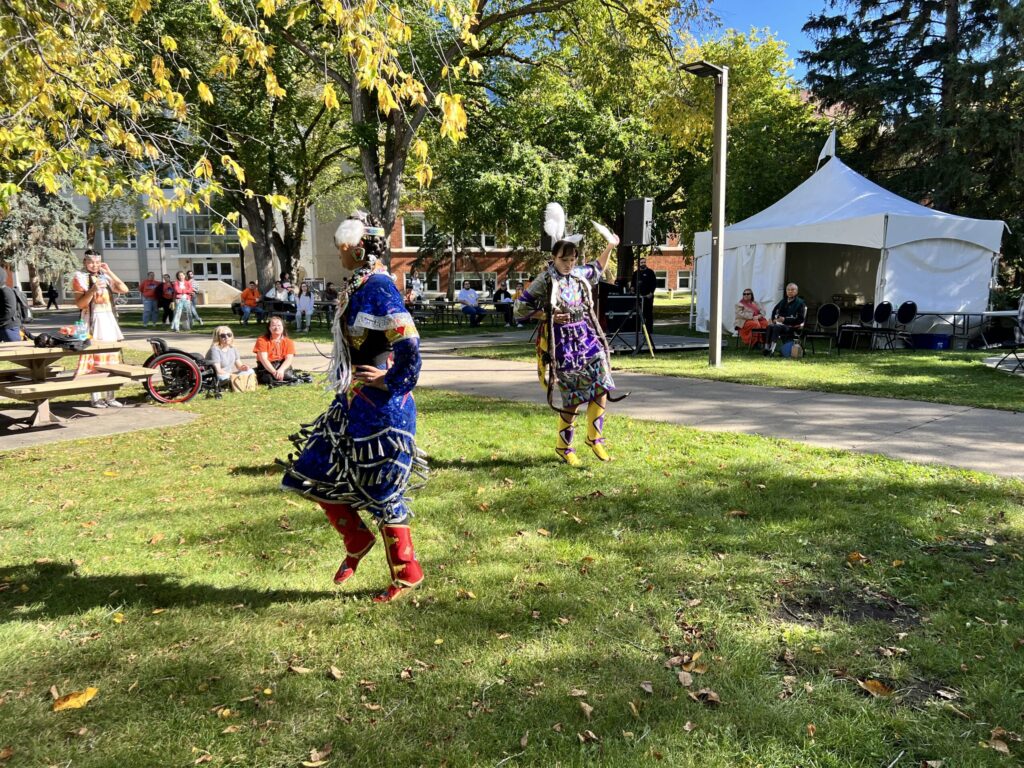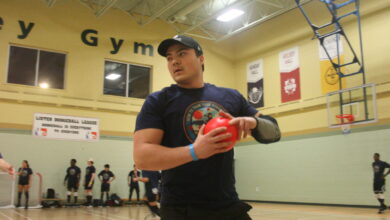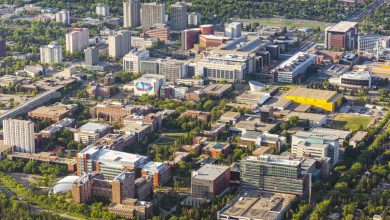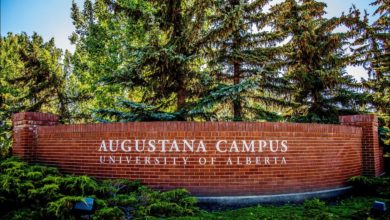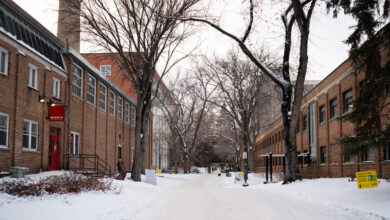U of A community gathers for fourth annual residential school memorial
”The purpose of this event is for our communities to heal,” ISU president says.
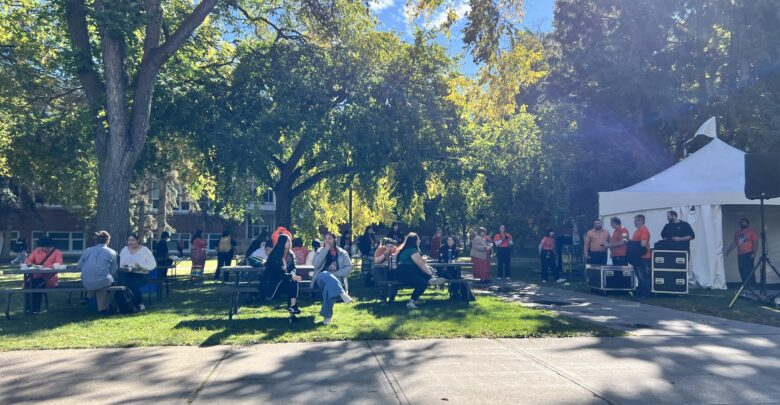 Peris Jones
Peris JonesOn September 27, the Indigenous Students’ Union (ISU) and the University of Alberta Students’ Union (UASU) held the fourth annual residential school memorial. Students and faculty members gathered in the Main Quad to participate in reconciliation and healing.
Indigenous students, faculty members, and community members shared knowledge and stories, followed by several performances from Indigenous artists. The memorial was held near the Sweetgrass Bear and was hosted by the chair of the UASU’s Aboriginal Relations and Reconciliation Committee (ARRC), Ella Thomson.
“The purpose of the event is for our communities to heal and hear our own stories from our own elders. And also for other people to stop in and come and be educated and take part in the ceremonies and the lands that they’re on, which I think is a really important part of decolonization,” ISU President Sophie Martel said.
Elder Eric John Large discusses the spectrum of reconciliation
The next speaker was Elder Eric John Large. Large is originally from Saddle Lake Cree Nation. He attended the Blue Quills Indian Residential School from grades one to eight, and then Racette School from grades nine to 12.
Large went on to receive a Bachelor’s of Education from the U of A in 1978. Additionally, he holds certificates in grief theory and trauma recovery.
Large is currently employed with the Acimowin Opaspiw Society as the lead investigator for the missing children and unmarked burial sites of the Blue Quills School.
“We’re going to commemorate on Monday, September 30. We’re going to go to the former cemetery [for the] former residential school that was established in 1898 to 1931 in Saddle Lake. And we’re going to remember these little ones, some of whose remains have not been found,” Large said.
There is a spectrum of reconciliation, according to Large. On one end of the spectrum, “there could be little acts, like this [memorial],” he said. “The other end of the spectrum to reconciliation [is getting the] land back.”
“There is no equity and no justice without truth,” Carrie Smith says
The next speaker, Carrie Smith, vice-provost (equity, diversity, and inclusion) (EDI) acknowledged that “we engage in equity work within the context of a colonial past and present.”
“The role I play in this university is to advance [EDI] towards institutional change, but there is no equity and no justice without truth,” Smith said.
According to Smith, “the U of A is committed to the journey of truth. And truth must include being willing to take up the invitation to bear witness and to learn from the stories of the survivors.”
“Our university commits to taking this journey of reconciliation and to working to honour the Indigenous worldview and resurgence while walking alongside and being guided by and uplifting First Nations, Métis, and Inuit students, staff, and faculty,” Smith said.
“I never understood any other way of being,” Florence Glanfield says
Vice-provost (Indigenous programming and research) Florence Glanfield was the next speaker. Glanfield is Métis as well as an alumna with several degrees from the U of A.
Growing up in northeastern Alberta, Glanfield discussed how she “never understood any other way of being. And now I’ve learned that people would [say] that we were living with the land.”
Glanfield said that she faced discrimination and stereotypes during her education at the U of A. She came to the U of A interested in studying mathematics, but in her first year of university, someone told her that they didn’t think Indigenous people could do mathematics.
“I want you to know that there are stereotypes. There were stereotypes of what we could do as Indigenous people — I just knew I was Native,” Glanfield said.
The memorial as well as National Day for Truth and Reconciliation is about “truth-telling,” according to Glanfield.
“We must be willing to tell the truth about where we are as an institution, as individuals, and as a collective,” she said. “The National Day for Truth and Reconciliation gives us an opportunity to reflect. To spend time remembering those that were taken away, sometimes at the ages of less than five years old to be put into residential schools.”
“Intergenerational trauma ends with us but we have to do that work,” Brooks Arcand-Paul says
Brooks Arcand-Paul is the member of the legislative assembly (MLA) for Edmonton-West Henday and Shadow Minister for Indigenous Relations for the Alberta New Democratic Party (NDP). He is also the first Two-Spirit MLA in Alberta history.
Arcand-Paul said that he is “honoured to do [the] work of requiring the provincial government to do the important work of recognizing their role in reconciliation.”
“There is so much more in reconciliation that we have to do. Most of the calls to action by the Truth and Reconciliation Commission (TRC) remain unfulfilled.”
In order for reconciliation to be complete, Arcand-Paul said that “we need to hold our governments accountable” because “our people are still suffering because of government inaction.”
According to Arcand-Paul, Indigenous people are over-incarcerated in prisons and Indigenous children enter the child welfare system at three times the rate of non-Indigenous children.
Arcand-Paul said that he plans to introduce a private member’s bill which, if passed, “will require the provincial government to complete the matters within the [TRC’s] calls to action.”
Arcand-Paul concluded his speech by saying that “the work we do in reconciliation is not even close to being over.”
“It is important to honour the children that did not come home, but it’s also important to honour [those] that are still with us. [Those] that went through the residential school system and who are still feeling the effects of this today. Intergenerational trauma ends with us but we have to do that work.”
Elder Fernie Marty doesn’t know what healing will look like, but it “has to start somewhere”
The final speaker was Elder Fernie Marty, who is originally from Cold Lake but married into Frog Lake First Nation. He is also a survivor of the Beaver Crossing residential day school.
Marty said that the fact that he is a day school survivor was “buried so deep inside of me, I didn’t even know it was there.”
“When I saw my name on the list [of day school survivors], all the hell I went through as a day school survivor hit me like a ton of bricks,” Marty said.
According to Marty, he didn’t know what to do next, but he knew that “the healing has to start somewhere.”
Marty said that he was able to forgive when Pope Francis came to visit Canada in 2022.
“He chose Canada to come and make that apology. When I got to shake his hand, he took my hand in both of his hands. In his language, he said ‘forgive me for what the church has done.’ I saw the tears and the emotion in that man’s face and I was able to forgive,” Marty said.
The best way to learn the truth is to talk to Indigenous Elders, Marty said. “[If] you want to learn the truth, you go and ask the elders, you’ll learn the truth.”
“You’re not going to learn this in the books because the government was so shameful, so spiteful, that they tried to change everything about the Indigenous peoples. And they’re still trying to this day.”
Lastly, the Foothills Drum group performed two songs, as well as accompaniments to four performances by four dancers. This was also followed by a group round dance in which all attendees were welcome and encouraged to participate.

